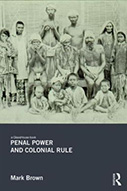Penal Power and Colonial Rule

Author: Mark Brown
Publisher: Abingdon, UK; New York: Routledge, 2014. 212p.
Reviewer: David Arnold | July 2014
India, the undeclared subject of Mark Brown’s book, has been no stranger to studies of crime, penology, and colonial practice in recent years, with particular attention directed to the so-called Thugs (organized gangs of professional assassins) in the early nineteenth century, and the “criminal tribes” policy in the later decades. Brown does not substantially depart from these well-honed topics, and his desire to use crime to provide a “unique lens” through which to view colonial rule does not, on the face of it, appear strikingly original. But he does bring new theoretical perspectives and fresh subject matter to bear. The first section of the book considers how, following Michel Foucault and David Scott, to develop a more nuanced notion of colonial governmentality — one that recognizes power as dispersed throughout the social order and not confined to strategies of colonial rule. Skeptical of simplistic binaries and critical of the attention given to race in recent scholarship, Brown favors an approach which addresses character and virtue, acknowledges a gulf between intentionality and effect, and sees the colonial state, far from united and homogenous, as constantly seeking to balance divergent views. Colonialism emerges as an expression of “liberal governmentality,” in which liberal values modulate and constrain the exercise of power, just as “native society” (or elements within it) has the capacity to inform state awareness. Rather than presuming the ubiquity of the panopticon, colonialism asks “why must we govern?” or “why must we intervene?”
Brown moves on to consider the “turbulent” or “dangerous” communities that became a primary object of colonial penal power. He argues that scholars who have written on the Thugs have overlooked the way in which Indian testimony, including that of Thug informants and approvers, was crucial to the way in which the British sought to understand, represent, and ultimately suppress Thugi. Penal knowledge was constituted through the Thug and through the concurrent interrogation of native character. This emergence of an ethnological governmental discourse and diagnostic strategy was deepened and developed in debates surrounding the Criminal Tribes Act of 1871. Here Brown sees more than one possible line of development, for as he shows by reference to the Minas, turbulent tribes could be reformed and “civilized” by the military through recruitment into special armed corps rather than being ostracized and criminalized as favored by the civilian administration. Criminal Tribes policy thus serves to show how the British, rather than following a single-stranded, authoritarian strategy, in fact argued extensively among themselves about the most principled or practical way of dealing with predatory groups. The operations of the act and the debates that led up to its revision in 1911, and the partial transfer of responsibility for its implementation from the state to the Salvation Army (before the legislation was finally wound up in the 1950s), are taken as further demonstrations of the “liberal” mechanics of colonial self-interest, an issue Brown further briefly elaborates in relation to two other colonial practices—whipping and the blowing of mutineers from guns during the uprising of 1857-58. It is significant that the crucial arenas for these debates and policy shifts lie not in the ordinary operations of the courts and daily legal process, but in the inner circles of government and in relation to marginal groups or moments of existential crisis. Brown concludes that the underlying principle was the British belief that the legitimacy of their tenure in India rested on the rule of law and all it could bring, from crime-control to development and security. But, in his view, the rule of law also operated as a restraint, intended in part to shape and guide Indian behavior but also to regulate official conduct. This “liberal” reading of colonial rule puts Brown at odds with some of the more extreme interpretations of Criminal Tribes policy, and he presents a valid case for revisiting a view (perhaps not widely held) of an almost untrammeled colonial appetite for coercion. But, without a more systematic enquiry into a wider (and arguably more representative) range of penal practices, it would be rash to accept the “liberal” nature of colonialism from these examples alone. In some ways Brown labors to establish the obvious. It can be no surprise to anyone familiar with colonial archives that issues like Thugi or the Criminal Tribes legislation attracted diverse opinion from within a divided administration; but this did not preclude the colonial regime from acting with singularity of purpose when it needed to. While opening up internal dissent within the administration, Brown seems unable to locate a corresponding agency within “native society,” which seldom seems here to have a voice or presence that is not mediated through colonial enquiry and debate. He is right to argue for a more socially inclusive and historically grounded view of colonial governmentality, but it is hard to see this as being adequately realized through the particular examples he cites.
David Arnold, Professor Emeritus, Department of History, University of Warwick, UK


